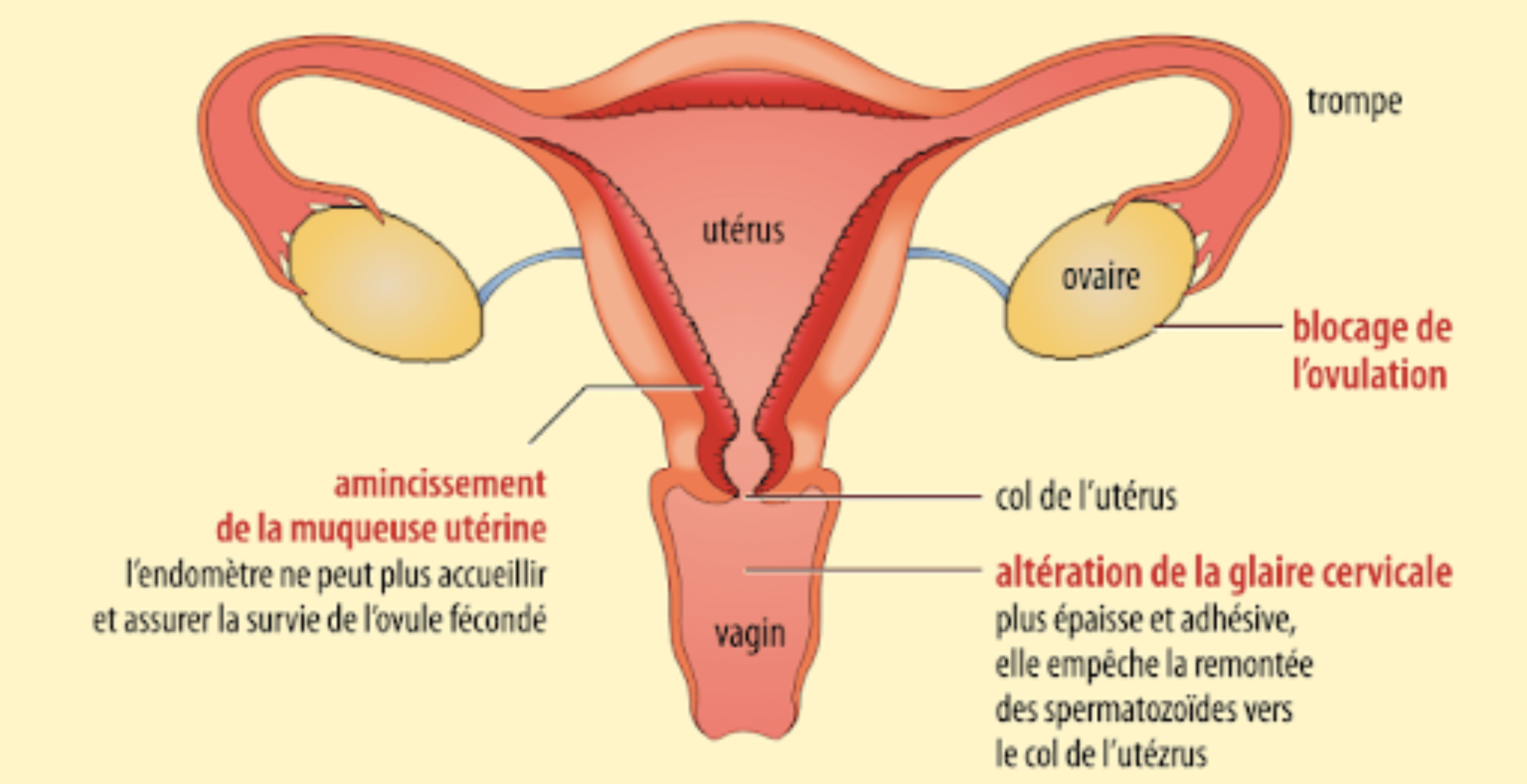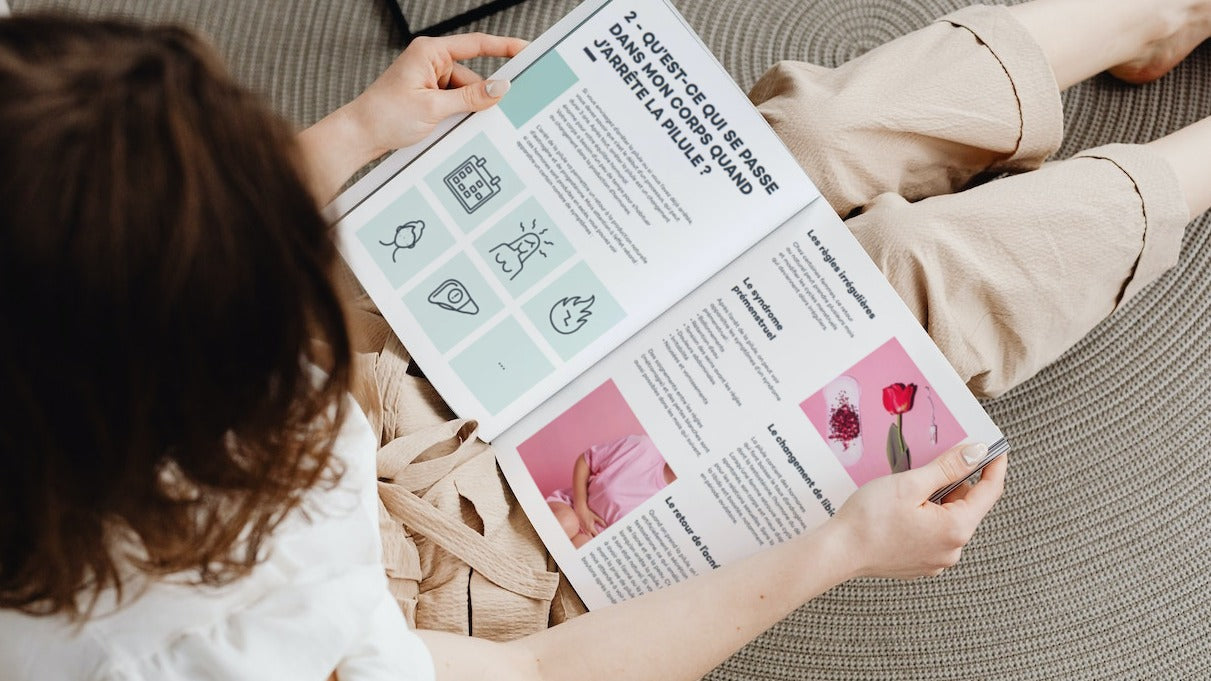
Stopping the pill is often difficult because it disrupts your entire hormonal system, which has been put on hold for a certain period. Your body must therefore readjust and learn to function on its own.
During this period and for the following 3 years, some symptoms may appear and affect your well-being:
premenstrual pain, irregular cycles, acne flare-ups, headaches, mood disorders… etc.
These symptoms that appear following the cessation of synthetic hormones are the ways your body uses to show that it needs help!
To prepare your body for stopping the pill or to rebalance it after stopping contraception for less than 3 years, you need to adapt your lifestyle, that is to say adjust all your daily choices and practices that impact your health and well-being. Women's dietary supplements are a great help in all your life moments.
Summary
I. The pill, how does it work?
The pills release synthetic hormones that resemble those naturally produced by your body. These hormones will disrupt, or even block your natural menstrual cycle.
There are two types of pills. The so-called "combined" or estrogen-progestin pills and the progestin-only pills that contain only a progestin.
Combined or oestroprogestative pills contain two hormones: an estrogen and a progestin. By providing a constant dose of synthetic hormones, the natural menstrual cycles are suppressed.
This type of contraception has 3 mechanisms of action:
Blockage of ovulation in the ovaries:
Combined pills aim to reduce the concentration in the blood of the two hormones responsible for ovulation and produced at the level of the pituitary gland: follicle-stimulating hormone (FSH) and luteinizing hormone (LH)
Blocking the sperm:
The progestin will thicken the cervical mucus at the cervix to make it impenetrable to spermatozoa
Make nesting impossible:
The combined pill also acts on the uterine lining, preventing the possible implantation of an embryo.
Progestative pills, on the other hand, are composed solely of a progestative hormone. These pills act on the thickness of the mucus at the cervix and, for some of them only, block ovulation. They are intended, for example, for women for whom taking estrogens is contraindicated.
Depending on the pill and the duration of its use, the effects on the body can vary. Some women may experience side effects such as mood changes, weight gain, or a decrease in libido. It is essential to consult a healthcare professional before choosing a contraceptive method to ensure it suits individual needs.
Furthermore, it is important to mention that the contraceptive pill does not offer protection against sexually transmitted infections (STIs). The combined use of condoms is therefore recommended for optimal protection.

Discover our e-book:
"How to better support our body before and after stopping the pill"

II. What happens in the body when you stop taking the pill?
If you are considering stopping the pill or if you have already stopped it, you should know that this is the beginning of a process that can last 3 years. After all, stopping the pill is a huge change for your hormonal balance. Your body needs some time to get used to the change in hormone production.
Stopping the pill will allow a return to the natural production of estrogen and progesterone. But beware of the rebound effect: if these hormones are produced in excess, you may experience a number of symptoms:
Irregular rules:
For some women, returning to natural can take a few months and alter menstrual cycles, which then become irregular.
Premenstrual syndrome:
After stopping the pill, symptoms of premenstrual syndrome may appear:
- Bloating
- Water retention
- Breast tension before menstruation
- Abdominal pain
- Irritability
- Nausea and vomiting
Bleeding between periods (metrorrhagia) and white discharge are also possible in the following months.
The change in libido:
The pill contains hormones that reduce the level of androgens, including testosterone, which is the hormone of desire. When a woman regains spontaneous cycles, her body is better prepared for sexual relations. Without the pill, libido is boosted, especially during the ovulatory period.
The return of acne:
When taking the pill, testosterone secretion is artificially blocked, which improves the condition of acne and the skin. That is why when you stop taking the pill, the skin returns to its natural state. If you tended to have acne or slightly oily skin before taking the pill, you should therefore expect to see some pimples reappear after stopping the pill.
The overworked liver:
When you have taken the pill for a long time, one of the most affected victims is... your liver! In the body, the liver filters, neutralizes, and eliminates toxins and synthetic molecules, including the hormones in the pill. All the toxins contained in the pill will overload the liver. It is the organ most affected with years of taking the pill.
When you stop taking the pill, your hormonal system is unbalanced and your liver is more overworked! It is therefore important to gently support the liver to help it in its work.
Emotional well-being:
Stopping the pill can also impact emotional well-being. Hormonal fluctuations can cause mood changes, anxiety, and even episodes of depression in some women. It is crucial to pay attention to these symptoms and seek support if necessary. Practices such as meditation, yoga, and regular physical activities can help stabilize mood and promote overall emotional well-being.
Other effects:
Several symptoms may appear when you stop taking the pill, sometimes spaced out over time and sometimes simultaneously. These symptoms are not systematic and do not necessarily affect all women.
When stopping, the drop in hormone levels can also cause headaches, weight gain, or hair loss. The quality of your hair can also be affected for a few months. Often, sebum production increases due to the hormonal whirlwind, and the hair becomes greasier. Usually, the change in the scalp does not last more than three months.

III. Hormonal rebalancing after stopping the pill
1. How to balance hormones after stopping the pill?
To rebalance hormones after stopping the pill, it is essential to adopt a holistic approach. This includes a balanced diet, appropriate dietary supplements, and wellness practices such as yoga or meditation. Dietary supplements can play a crucial role by providing the necessary nutrients to support the hormonal system. For example, D-LAB NUTRICOSMETICS' Post-Pill Detox is designed to help restore hormonal balance and support the elimination organs.
2. Promote a holistic approach to hormonal well-being
In addition to dietary supplements, incorporating stress management techniques such as deep breathing or massages can also help stabilize hormones. Maintaining regular physical activity is crucial, as exercise helps regulate hormones and improve mood. A good night's sleep is also essential to allow the body to recover and function properly.
IV. How to minimize side effects through diet?
Stopping the pill is a key moment during which your body will have specific needs to regain its balance.
Here are our tips to minimize side effects:
- Give your body all the necessary nutrients. When stopping the pill, your body needs significant resources to regain its hormonal balance. It is important to eat enough, in a varied and structured way (proteins, carbohydrates, and fats) to provide all the elements the body needs daily. Stock up on good fats, vitamins, and minerals.
- Minimize toxic load as much as possible: avoid consuming industrial and processed products (ready meals, cold cuts, etc.), food additives, and all foods rich in sugars and processed fatty acids.
- Take care of your liver, which is responsible for neutralizing used estrogens. Your liver loves vegetables rich in chlorophyll (dark green in color) and sulfur-containing (cabbage, broccoli). These foods contribute to cell regeneration and help eliminate toxins and limit hormonal excesses. You can also support your liver with appropriate plants: milk thistle, artichoke, black radish, or dandelion... Drinking plenty of water will also help the liver and the entire waste elimination system to effectively remove toxins.
- Promote your intestinal transit: Constipation is the number one enemy of your feminine balance. You can take a probiotic treatment for three months to restore your intestinal balance and renew it twice a year, according to your needs.
1. Additional tips for a balanced diet
It is also beneficial to incorporate anti-inflammatory foods into your diet. The omega-3s found in fatty fish like salmon, chia seeds, and walnuts are excellent choices to reduce inflammation and support hormonal health. Additionally, the antioxidants present in berries, citrus fruits, and colorful vegetables can help combat oxidative stress, often exacerbated by hormonal fluctuations.
Dietary fibers play a crucial role in hormonal regulation. They help stabilize blood sugar levels and improve digestion, which is essential for overall well-being. Cruciferous vegetables like broccoli and cauliflower are particularly recommended for their ability to help the body eliminate excess estrogens.
Finally, it is important not to overlook the importance of adequate hydration. Drinking enough water each day not only helps maintain healthy skin but also supports the body's natural detoxification processes.
2. How to detox from the pill?
Detoxification after stopping the pill is essential to help the body eliminate accumulated toxins and restore a natural hormonal balance. Here are some tips for effective detoxification:
- Hydration: Drinking plenty of water helps eliminate toxins and supports the liver in its detoxification process.
- Detox foods: Incorporating foods rich in antioxidants and fiber, such as green vegetables, fresh fruits, and whole grains, can help purify the body.
- Medicinal plants: Using plants such as milk thistle, dandelion, and artichoke can support liver function and promote the elimination of toxins.
- Dietary supplements: Specific supplements, such as the D-LAB NUTRICOSMETICS Post-Pill Detox, can provide the necessary nutrients to support the detoxification process.
V. Holistic dietary supplements
Composed of vitamins, minerals, trace elements, and plant extracts, dietary supplements are a natural and effective way to rebalance the body after stopping the pill. They act directly at the cellular level and provide the necessary micronutrients to alleviate post-pill symptoms.
To allow women to experience the cessation of their hormonal contraception calmly, or for those who have already stopped, D-LAB has developed the Post-Pill Detox, created in collaboration with Amal Tahir, coach, writer, specialized in positive sexuality.
A 100% clean and vegan formula that supports the female hormonal system as well as the excretory organs involved in the detoxification process, to prepare the body for stopping the pill but also to support women who have already stopped the pill in the past 3 years and thus avoid related symptoms.
1 - Restores hormonal balance
The Post-Pill Detox helps restore hormonal balance to relieve symptoms related to stopping the pill: premenstrual pain, irregular cycles, headaches, mood disorders… etc.
- Vitamin B6 regulates hormonal activity by maintaining normal levels of estrogen and progesterone. It acts on symptoms such as anxiety, irritability, and premenstrual nervous tension.
- Evening primrose oil, composed of gamma-linolenic and linoleic acids, helps regulate the hormonal system, maintain optimal comfort during menstruation, and aids in combating menstrual pain and hot flashes.
- The centifolia rose supports the function of the sexual organs and helps maintain a comfortable menstrual cycle. It helps alleviate premenstrual syndrome, cramps, and moodiness.
2 - Preserves skin health
The Post-Pill Detox contains herbal plants, vitamins, and essential minerals for good skin health to prevent these common skin problems and post-pill skin sensitivity.
- Zinc is a trace element essential for the skin and beneficial in reducing imperfections. It helps regulate sebum production, thereby preventing pore blockage and allowing the skin to breathe. Zinc also promotes the regeneration of skin cells and fights against the effects of cellular aging.
- Lodhra has astringent properties effective against acne. It helps to keep the skin healthy and improves the complexion.
3 - Detoxifies the body
The Post-Pill Detox protects and supports liver health to promote the elimination and purification of the body.
- Milk thistle contains silymarin, an ultra-effective hepatoprotective active ingredient. It deeply purifies the body, eliminates toxins present in the liver, and promotes rapid regeneration of damaged tissues.
- Burdock is a cleansing plant known for promoting the elimination of toxins and the purification of the blood.

What are the other methods of contraception?
While the contraceptive pill remains the most widely used method of contraception in France, it is far from being the only one. Today, more and more women are choosing to switch to hormone-free contraception.
If you are tired of taking the pill every day or if you poorly tolerate its side effects, hormone-free contraception can be a solution.
The condom
The male condom is one of the most commonly used hormone-free contraception methods. Made of latex or polyurethane, it not only prevents sperm from passing through, but it is also the only way to avoid the transmission of STIs (sexually transmitted infections).
There are also female condoms to be placed in the vagina before sexual intercourse. It is equipped with a ring at each end of the condom to keep it in place and prevent it from being sucked into the vagina.
Effectiveness rate with perfect use: 98% – With typical use: 85%
The IUD or hormone-free coil
The IUD (intrauterine device) is the most commonly recommended hormone-free contraception. It is also a very reliable contraception that you can wear for 5 to 10 years.
How does it work? The IUD consists of a thin copper wire that releases copper ions. These ions cause an inflammatory response in the walls of the uterus (endometrium) which creates an inhospitable environment for sperm and prevents the implantation of the egg, even if it is fertilized.
However, this method of contraception can cause side effects in some women such as heavier periods and/or pain.
Effectiveness rate with perfect use: 99.4% – With typical use: 99.2%
Diaphragm and cervical cape
Diaphragms and cervical caps are non-hormonal contraceptives for women that are used with spermicides at the time of sexual intercourse.
It is a membrane made of latex or silicone that must be placed by oneself in the vagina near the cervix just before intercourse. These devices thus block the passage of sperm. They must remain in place for at least 6 hours after intercourse.
They are used only during intercourse and must be removed afterwards, at least 6 to 8 hours after intercourse.
These two devices are available by prescription only. You must first seek advice from your gynecologist or midwife before using them.
Effectiveness rate with perfect use: 84% – With typical use: 83%
Cycle Observation Methods (COM)
MOCs require monitoring fertility indicators (such as cervical mucus, temperature variations, or the position of the cervix) and using additional protection during fertile days.
This natural contraception method is called "symptothermal": it mainly combines two fertility indicators:
1 - Observation of cervical mucus:
As ovulation approaches, cervical mucus becomes more abundant, more fluid, and more stringy. At the time of ovulation, the mucus takes on the consistency of egg white.
On the other hand, during non-fertile days, cervical mucus is generally drier and less easy to observe.
2 - Temperature observation
After ovulation, the body temperature rises. It can be easily measured in the morning using a thermometer.
By recording fertility signs daily and plotting them on a chart called a "cyclogram," you will be able to determine your fertility window for the current cycle.
During your fertile period, two possibilities are available to you:
- You can protect yourself with mechanical contraception (condom, diaphragm, cervical cap...). The failure rate is then 1.8%.
- You can choose with your partner abstinence or a sexuality without penetration. Here, the failure rate will then be around 0.5%
Non-oral hormonal methods
For those who want hormonal contraception but prefer to avoid the pill, there are non-oral options such as the contraceptive patch, the vaginal ring, and the implant.
- The contraceptive patch: Applied to the skin, the patch releases hormones similar to those in the combined pill. It must be changed every week.
- The vaginal ring: Inserted into the vagina, it releases hormones continuously over a period of three weeks, followed by one week without the ring to allow menstruation.
- The implant: A small rod inserted under the skin of the arm, it releases progestins for a duration of up to three years.
These methods offer a convenient alternative for those who may have difficulty remembering to take a pill every day.
Effectiveness rate with perfect use: 99% – With typical use: 91-99%
Sterilization
Sterilization is a permanent option for those who are certain they no longer want children. In women, tubal sterilization (or tubal ligation) blocks the fallopian tubes to prevent eggs from meeting sperm. In men, vasectomy prevents sperm from mixing with the ejaculated semen.
These methods are very reliable but should be considered irreversible. They require careful consideration and are often preceded by a period of legal reflection.
Efficiency rate in perfect and typical use: over 99%
In conclusion, there are many alternatives to the contraceptive pill, each with its advantages and disadvantages. It is essential to choose a method suited to one's lifestyle, needs, and personal preferences. It is recommended to consult a healthcare professional to discuss all available options in order to make an informed decision.







